Australian Economic Challenges and Policies
VerifiedAdded on 2020/03/28
|10
|2256
|44
AI Summary
This assignment delves into the multifaceted economic challenges confronting Australia in the 21st century. It examines issues such as the impact of the mining boom's decline, managing carbon emissions, and navigating global trade barriers, including potential implications from rising protectionism. The analysis also explores strategies and policy recommendations to foster sustainable economic growth and address these critical concerns.
Contribute Materials
Your contribution can guide someone’s learning journey. Share your
documents today.
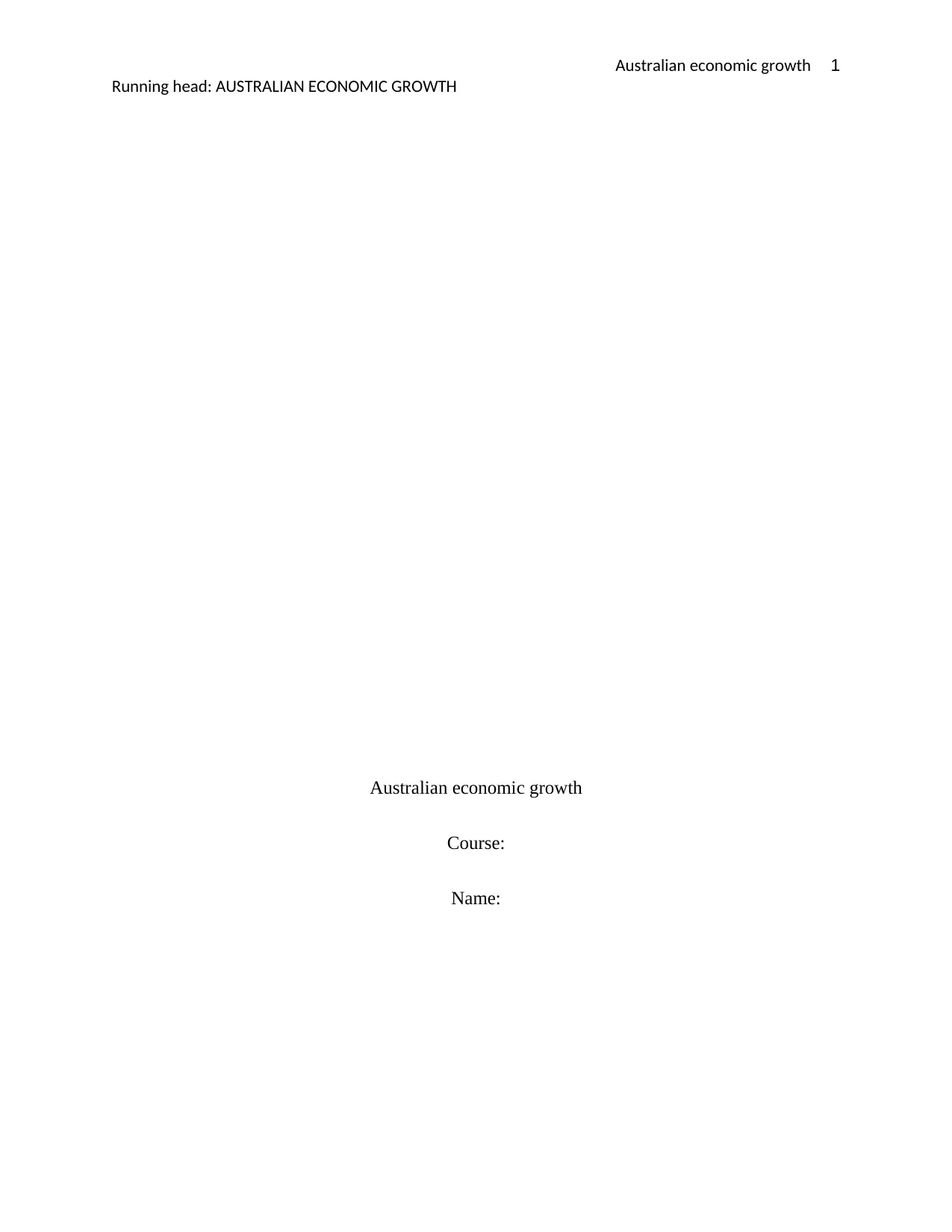
1Australian economic growth
Running head: AUSTRALIAN ECONOMIC GROWTH
Australian economic growth
Course:
Name:
Running head: AUSTRALIAN ECONOMIC GROWTH
Australian economic growth
Course:
Name:
Secure Best Marks with AI Grader
Need help grading? Try our AI Grader for instant feedback on your assignments.
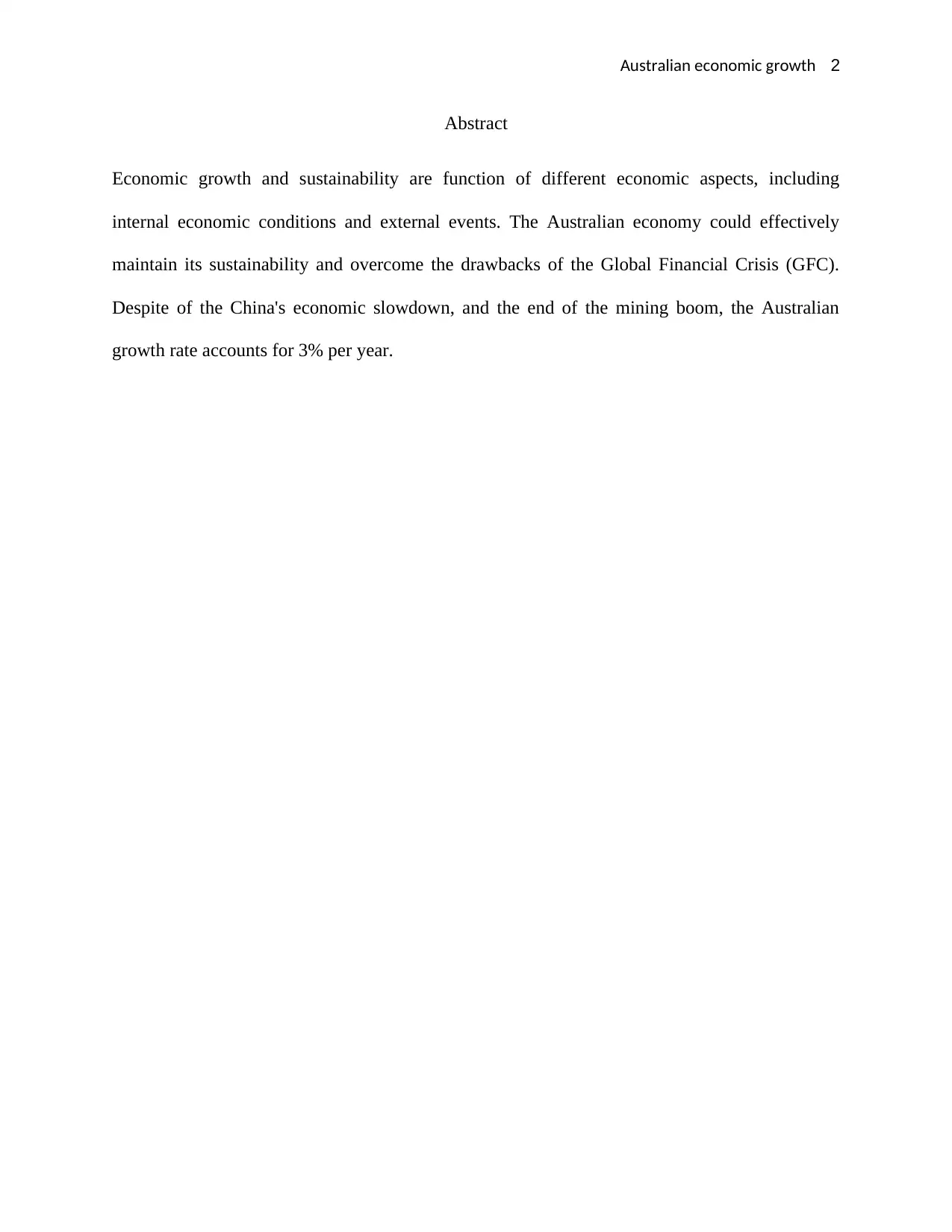
2Australian economic growth
Abstract
Economic growth and sustainability are function of different economic aspects, including
internal economic conditions and external events. The Australian economy could effectively
maintain its sustainability and overcome the drawbacks of the Global Financial Crisis (GFC).
Despite of the China's economic slowdown, and the end of the mining boom, the Australian
growth rate accounts for 3% per year.
Abstract
Economic growth and sustainability are function of different economic aspects, including
internal economic conditions and external events. The Australian economy could effectively
maintain its sustainability and overcome the drawbacks of the Global Financial Crisis (GFC).
Despite of the China's economic slowdown, and the end of the mining boom, the Australian
growth rate accounts for 3% per year.
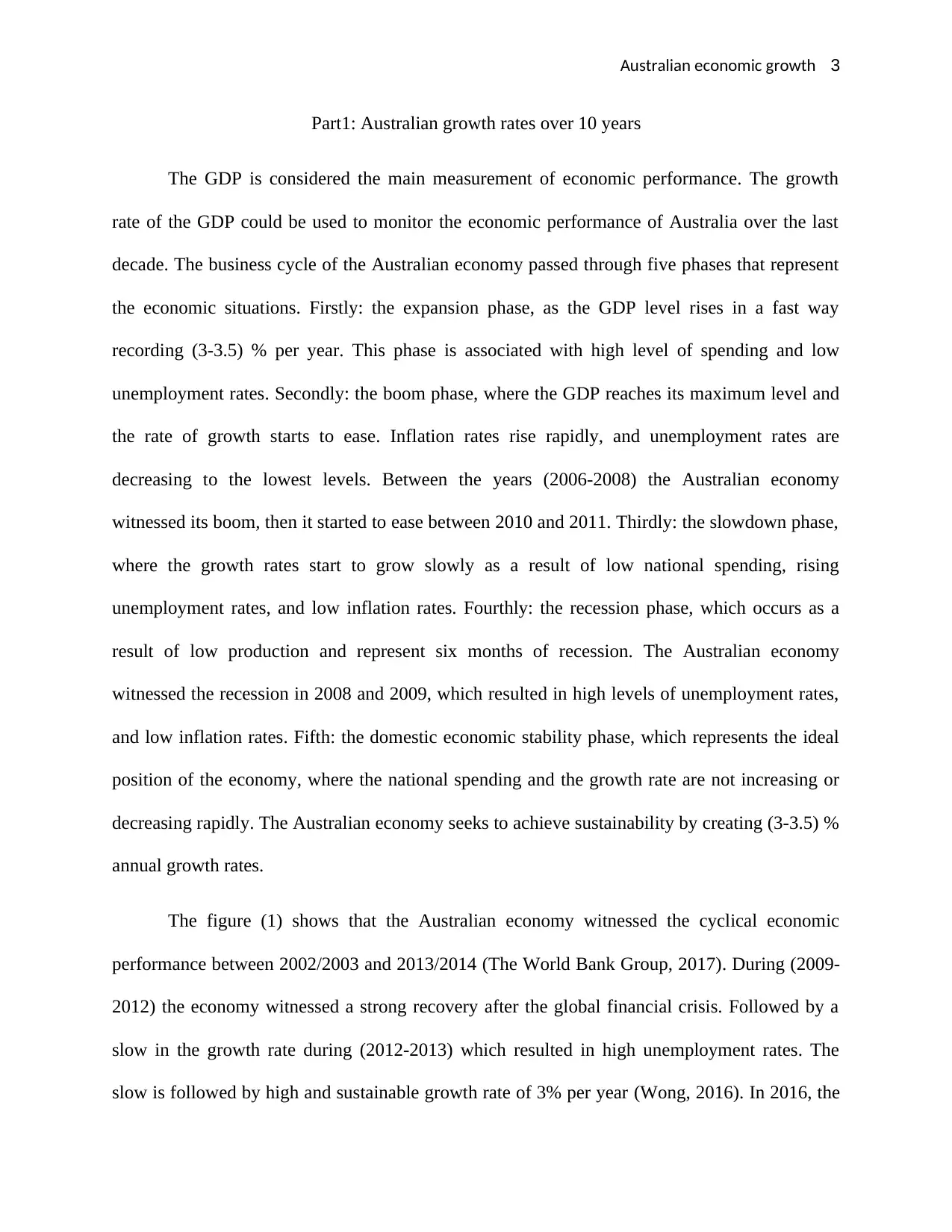
3Australian economic growth
Part1: Australian growth rates over 10 years
The GDP is considered the main measurement of economic performance. The growth
rate of the GDP could be used to monitor the economic performance of Australia over the last
decade. The business cycle of the Australian economy passed through five phases that represent
the economic situations. Firstly: the expansion phase, as the GDP level rises in a fast way
recording (3-3.5) % per year. This phase is associated with high level of spending and low
unemployment rates. Secondly: the boom phase, where the GDP reaches its maximum level and
the rate of growth starts to ease. Inflation rates rise rapidly, and unemployment rates are
decreasing to the lowest levels. Between the years (2006-2008) the Australian economy
witnessed its boom, then it started to ease between 2010 and 2011. Thirdly: the slowdown phase,
where the growth rates start to grow slowly as a result of low national spending, rising
unemployment rates, and low inflation rates. Fourthly: the recession phase, which occurs as a
result of low production and represent six months of recession. The Australian economy
witnessed the recession in 2008 and 2009, which resulted in high levels of unemployment rates,
and low inflation rates. Fifth: the domestic economic stability phase, which represents the ideal
position of the economy, where the national spending and the growth rate are not increasing or
decreasing rapidly. The Australian economy seeks to achieve sustainability by creating (3-3.5) %
annual growth rates.
The figure (1) shows that the Australian economy witnessed the cyclical economic
performance between 2002/2003 and 2013/2014 (The World Bank Group, 2017). During (2009-
2012) the economy witnessed a strong recovery after the global financial crisis. Followed by a
slow in the growth rate during (2012-2013) which resulted in high unemployment rates. The
slow is followed by high and sustainable growth rate of 3% per year (Wong, 2016). In 2016, the
Part1: Australian growth rates over 10 years
The GDP is considered the main measurement of economic performance. The growth
rate of the GDP could be used to monitor the economic performance of Australia over the last
decade. The business cycle of the Australian economy passed through five phases that represent
the economic situations. Firstly: the expansion phase, as the GDP level rises in a fast way
recording (3-3.5) % per year. This phase is associated with high level of spending and low
unemployment rates. Secondly: the boom phase, where the GDP reaches its maximum level and
the rate of growth starts to ease. Inflation rates rise rapidly, and unemployment rates are
decreasing to the lowest levels. Between the years (2006-2008) the Australian economy
witnessed its boom, then it started to ease between 2010 and 2011. Thirdly: the slowdown phase,
where the growth rates start to grow slowly as a result of low national spending, rising
unemployment rates, and low inflation rates. Fourthly: the recession phase, which occurs as a
result of low production and represent six months of recession. The Australian economy
witnessed the recession in 2008 and 2009, which resulted in high levels of unemployment rates,
and low inflation rates. Fifth: the domestic economic stability phase, which represents the ideal
position of the economy, where the national spending and the growth rate are not increasing or
decreasing rapidly. The Australian economy seeks to achieve sustainability by creating (3-3.5) %
annual growth rates.
The figure (1) shows that the Australian economy witnessed the cyclical economic
performance between 2002/2003 and 2013/2014 (The World Bank Group, 2017). During (2009-
2012) the economy witnessed a strong recovery after the global financial crisis. Followed by a
slow in the growth rate during (2012-2013) which resulted in high unemployment rates. The
slow is followed by high and sustainable growth rate of 3% per year (Wong, 2016). In 2016, the
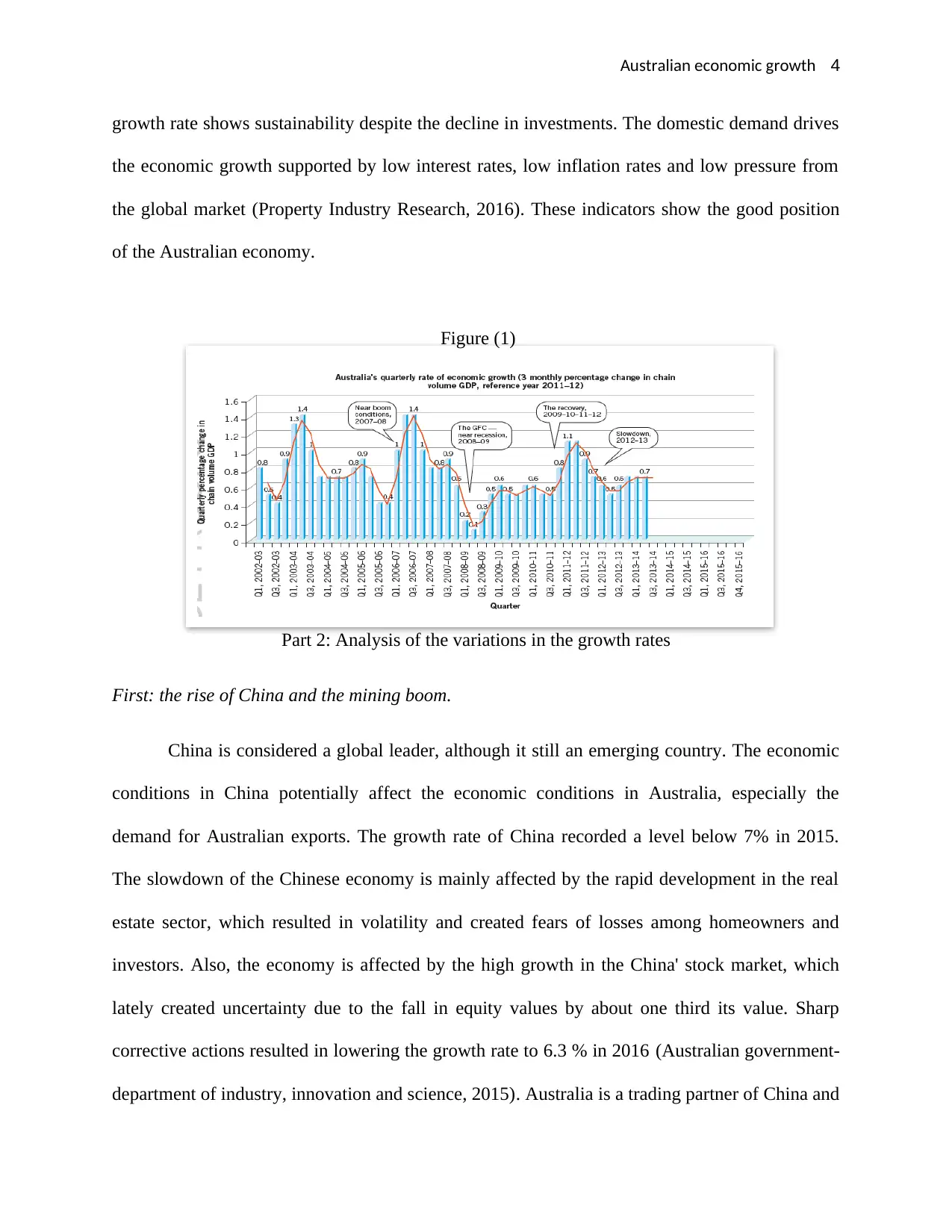
4Australian economic growth
growth rate shows sustainability despite the decline in investments. The domestic demand drives
the economic growth supported by low interest rates, low inflation rates and low pressure from
the global market (Property Industry Research, 2016). These indicators show the good position
of the Australian economy.
Part 2: Analysis of the variations in the growth rates
First: the rise of China and the mining boom.
China is considered a global leader, although it still an emerging country. The economic
conditions in China potentially affect the economic conditions in Australia, especially the
demand for Australian exports. The growth rate of China recorded a level below 7% in 2015.
The slowdown of the Chinese economy is mainly affected by the rapid development in the real
estate sector, which resulted in volatility and created fears of losses among homeowners and
investors. Also, the economy is affected by the high growth in the China' stock market, which
lately created uncertainty due to the fall in equity values by about one third its value. Sharp
corrective actions resulted in lowering the growth rate to 6.3 % in 2016 (Australian government-
department of industry, innovation and science, 2015). Australia is a trading partner of China and
Figure (1)
growth rate shows sustainability despite the decline in investments. The domestic demand drives
the economic growth supported by low interest rates, low inflation rates and low pressure from
the global market (Property Industry Research, 2016). These indicators show the good position
of the Australian economy.
Part 2: Analysis of the variations in the growth rates
First: the rise of China and the mining boom.
China is considered a global leader, although it still an emerging country. The economic
conditions in China potentially affect the economic conditions in Australia, especially the
demand for Australian exports. The growth rate of China recorded a level below 7% in 2015.
The slowdown of the Chinese economy is mainly affected by the rapid development in the real
estate sector, which resulted in volatility and created fears of losses among homeowners and
investors. Also, the economy is affected by the high growth in the China' stock market, which
lately created uncertainty due to the fall in equity values by about one third its value. Sharp
corrective actions resulted in lowering the growth rate to 6.3 % in 2016 (Australian government-
department of industry, innovation and science, 2015). Australia is a trading partner of China and
Figure (1)
Secure Best Marks with AI Grader
Need help grading? Try our AI Grader for instant feedback on your assignments.
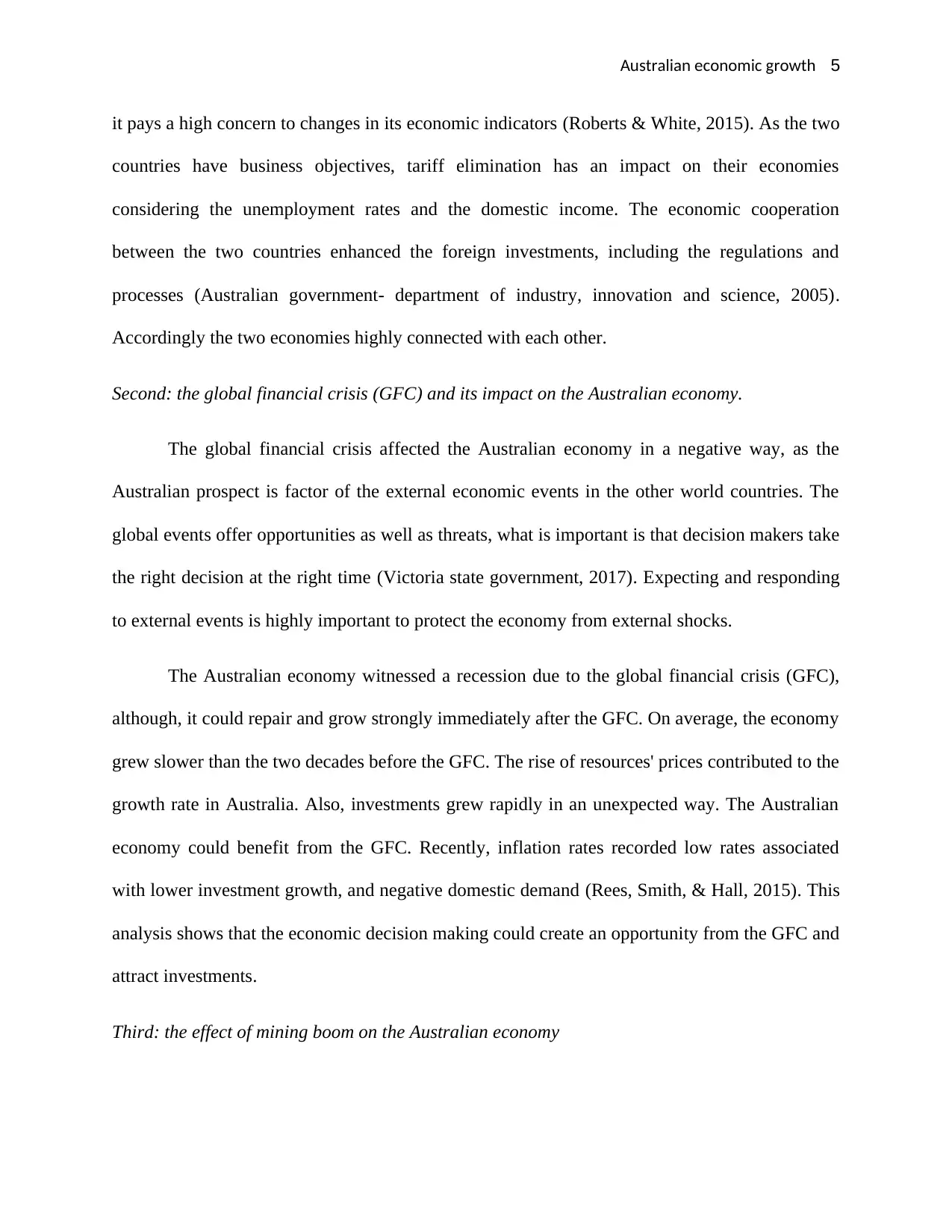
5Australian economic growth
it pays a high concern to changes in its economic indicators (Roberts & White, 2015). As the two
countries have business objectives, tariff elimination has an impact on their economies
considering the unemployment rates and the domestic income. The economic cooperation
between the two countries enhanced the foreign investments, including the regulations and
processes (Australian government- department of industry, innovation and science, 2005).
Accordingly the two economies highly connected with each other.
Second: the global financial crisis (GFC) and its impact on the Australian economy.
The global financial crisis affected the Australian economy in a negative way, as the
Australian prospect is factor of the external economic events in the other world countries. The
global events offer opportunities as well as threats, what is important is that decision makers take
the right decision at the right time (Victoria state government, 2017). Expecting and responding
to external events is highly important to protect the economy from external shocks.
The Australian economy witnessed a recession due to the global financial crisis (GFC),
although, it could repair and grow strongly immediately after the GFC. On average, the economy
grew slower than the two decades before the GFC. The rise of resources' prices contributed to the
growth rate in Australia. Also, investments grew rapidly in an unexpected way. The Australian
economy could benefit from the GFC. Recently, inflation rates recorded low rates associated
with lower investment growth, and negative domestic demand (Rees, Smith, & Hall, 2015). This
analysis shows that the economic decision making could create an opportunity from the GFC and
attract investments.
Third: the effect of mining boom on the Australian economy
it pays a high concern to changes in its economic indicators (Roberts & White, 2015). As the two
countries have business objectives, tariff elimination has an impact on their economies
considering the unemployment rates and the domestic income. The economic cooperation
between the two countries enhanced the foreign investments, including the regulations and
processes (Australian government- department of industry, innovation and science, 2005).
Accordingly the two economies highly connected with each other.
Second: the global financial crisis (GFC) and its impact on the Australian economy.
The global financial crisis affected the Australian economy in a negative way, as the
Australian prospect is factor of the external economic events in the other world countries. The
global events offer opportunities as well as threats, what is important is that decision makers take
the right decision at the right time (Victoria state government, 2017). Expecting and responding
to external events is highly important to protect the economy from external shocks.
The Australian economy witnessed a recession due to the global financial crisis (GFC),
although, it could repair and grow strongly immediately after the GFC. On average, the economy
grew slower than the two decades before the GFC. The rise of resources' prices contributed to the
growth rate in Australia. Also, investments grew rapidly in an unexpected way. The Australian
economy could benefit from the GFC. Recently, inflation rates recorded low rates associated
with lower investment growth, and negative domestic demand (Rees, Smith, & Hall, 2015). This
analysis shows that the economic decision making could create an opportunity from the GFC and
attract investments.
Third: the effect of mining boom on the Australian economy
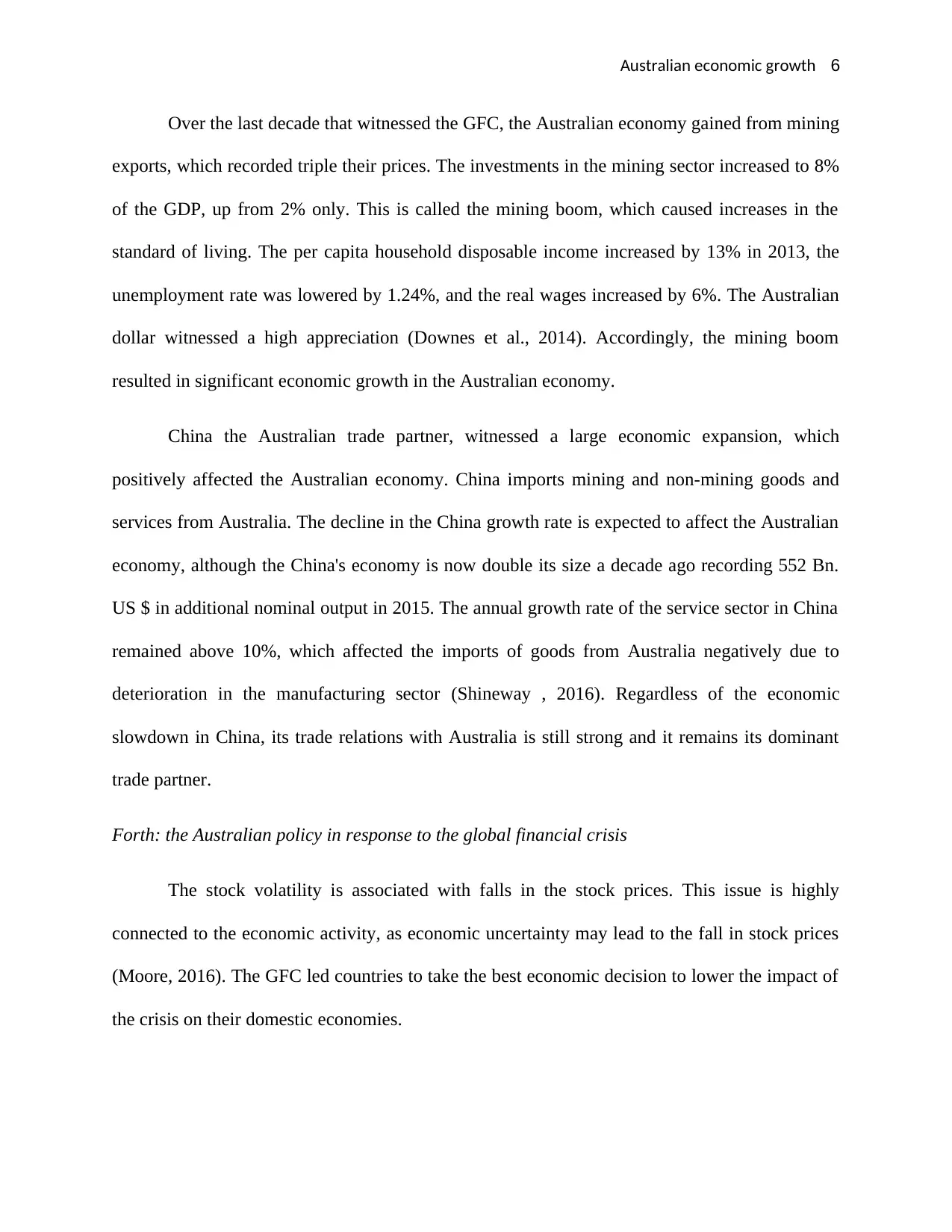
6Australian economic growth
Over the last decade that witnessed the GFC, the Australian economy gained from mining
exports, which recorded triple their prices. The investments in the mining sector increased to 8%
of the GDP, up from 2% only. This is called the mining boom, which caused increases in the
standard of living. The per capita household disposable income increased by 13% in 2013, the
unemployment rate was lowered by 1.24%, and the real wages increased by 6%. The Australian
dollar witnessed a high appreciation (Downes et al., 2014). Accordingly, the mining boom
resulted in significant economic growth in the Australian economy.
China the Australian trade partner, witnessed a large economic expansion, which
positively affected the Australian economy. China imports mining and non-mining goods and
services from Australia. The decline in the China growth rate is expected to affect the Australian
economy, although the China's economy is now double its size a decade ago recording 552 Bn.
US $ in additional nominal output in 2015. The annual growth rate of the service sector in China
remained above 10%, which affected the imports of goods from Australia negatively due to
deterioration in the manufacturing sector (Shineway , 2016). Regardless of the economic
slowdown in China, its trade relations with Australia is still strong and it remains its dominant
trade partner.
Forth: the Australian policy in response to the global financial crisis
The stock volatility is associated with falls in the stock prices. This issue is highly
connected to the economic activity, as economic uncertainty may lead to the fall in stock prices
(Moore, 2016). The GFC led countries to take the best economic decision to lower the impact of
the crisis on their domestic economies.
Over the last decade that witnessed the GFC, the Australian economy gained from mining
exports, which recorded triple their prices. The investments in the mining sector increased to 8%
of the GDP, up from 2% only. This is called the mining boom, which caused increases in the
standard of living. The per capita household disposable income increased by 13% in 2013, the
unemployment rate was lowered by 1.24%, and the real wages increased by 6%. The Australian
dollar witnessed a high appreciation (Downes et al., 2014). Accordingly, the mining boom
resulted in significant economic growth in the Australian economy.
China the Australian trade partner, witnessed a large economic expansion, which
positively affected the Australian economy. China imports mining and non-mining goods and
services from Australia. The decline in the China growth rate is expected to affect the Australian
economy, although the China's economy is now double its size a decade ago recording 552 Bn.
US $ in additional nominal output in 2015. The annual growth rate of the service sector in China
remained above 10%, which affected the imports of goods from Australia negatively due to
deterioration in the manufacturing sector (Shineway , 2016). Regardless of the economic
slowdown in China, its trade relations with Australia is still strong and it remains its dominant
trade partner.
Forth: the Australian policy in response to the global financial crisis
The stock volatility is associated with falls in the stock prices. This issue is highly
connected to the economic activity, as economic uncertainty may lead to the fall in stock prices
(Moore, 2016). The GFC led countries to take the best economic decision to lower the impact of
the crisis on their domestic economies.
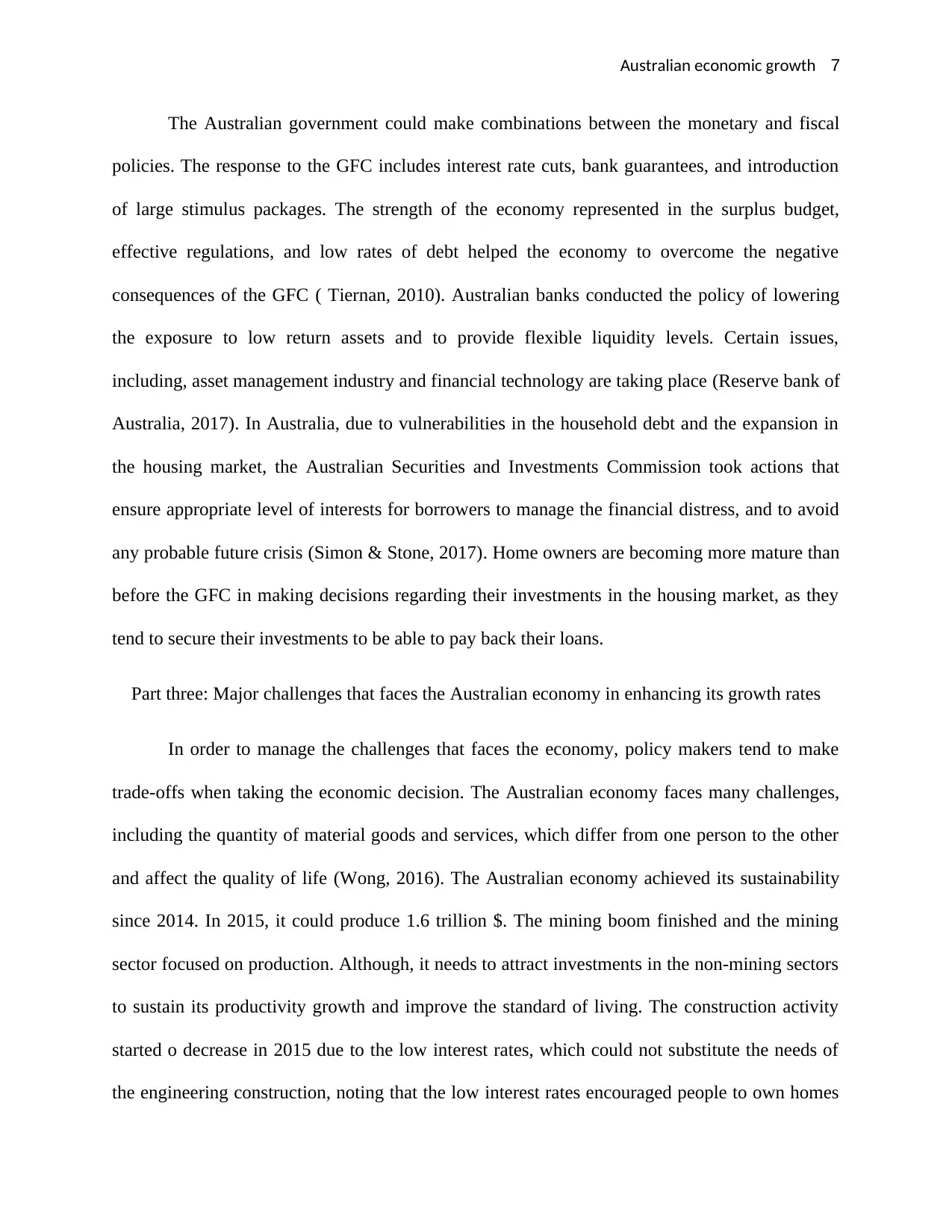
7Australian economic growth
The Australian government could make combinations between the monetary and fiscal
policies. The response to the GFC includes interest rate cuts, bank guarantees, and introduction
of large stimulus packages. The strength of the economy represented in the surplus budget,
effective regulations, and low rates of debt helped the economy to overcome the negative
consequences of the GFC ( Tiernan, 2010). Australian banks conducted the policy of lowering
the exposure to low return assets and to provide flexible liquidity levels. Certain issues,
including, asset management industry and financial technology are taking place (Reserve bank of
Australia, 2017). In Australia, due to vulnerabilities in the household debt and the expansion in
the housing market, the Australian Securities and Investments Commission took actions that
ensure appropriate level of interests for borrowers to manage the financial distress, and to avoid
any probable future crisis (Simon & Stone, 2017). Home owners are becoming more mature than
before the GFC in making decisions regarding their investments in the housing market, as they
tend to secure their investments to be able to pay back their loans.
Part three: Major challenges that faces the Australian economy in enhancing its growth rates
In order to manage the challenges that faces the economy, policy makers tend to make
trade-offs when taking the economic decision. The Australian economy faces many challenges,
including the quantity of material goods and services, which differ from one person to the other
and affect the quality of life (Wong, 2016). The Australian economy achieved its sustainability
since 2014. In 2015, it could produce 1.6 trillion $. The mining boom finished and the mining
sector focused on production. Although, it needs to attract investments in the non-mining sectors
to sustain its productivity growth and improve the standard of living. The construction activity
started o decrease in 2015 due to the low interest rates, which could not substitute the needs of
the engineering construction, noting that the low interest rates encouraged people to own homes
The Australian government could make combinations between the monetary and fiscal
policies. The response to the GFC includes interest rate cuts, bank guarantees, and introduction
of large stimulus packages. The strength of the economy represented in the surplus budget,
effective regulations, and low rates of debt helped the economy to overcome the negative
consequences of the GFC ( Tiernan, 2010). Australian banks conducted the policy of lowering
the exposure to low return assets and to provide flexible liquidity levels. Certain issues,
including, asset management industry and financial technology are taking place (Reserve bank of
Australia, 2017). In Australia, due to vulnerabilities in the household debt and the expansion in
the housing market, the Australian Securities and Investments Commission took actions that
ensure appropriate level of interests for borrowers to manage the financial distress, and to avoid
any probable future crisis (Simon & Stone, 2017). Home owners are becoming more mature than
before the GFC in making decisions regarding their investments in the housing market, as they
tend to secure their investments to be able to pay back their loans.
Part three: Major challenges that faces the Australian economy in enhancing its growth rates
In order to manage the challenges that faces the economy, policy makers tend to make
trade-offs when taking the economic decision. The Australian economy faces many challenges,
including the quantity of material goods and services, which differ from one person to the other
and affect the quality of life (Wong, 2016). The Australian economy achieved its sustainability
since 2014. In 2015, it could produce 1.6 trillion $. The mining boom finished and the mining
sector focused on production. Although, it needs to attract investments in the non-mining sectors
to sustain its productivity growth and improve the standard of living. The construction activity
started o decrease in 2015 due to the low interest rates, which could not substitute the needs of
the engineering construction, noting that the low interest rates encouraged people to own homes
Paraphrase This Document
Need a fresh take? Get an instant paraphrase of this document with our AI Paraphraser
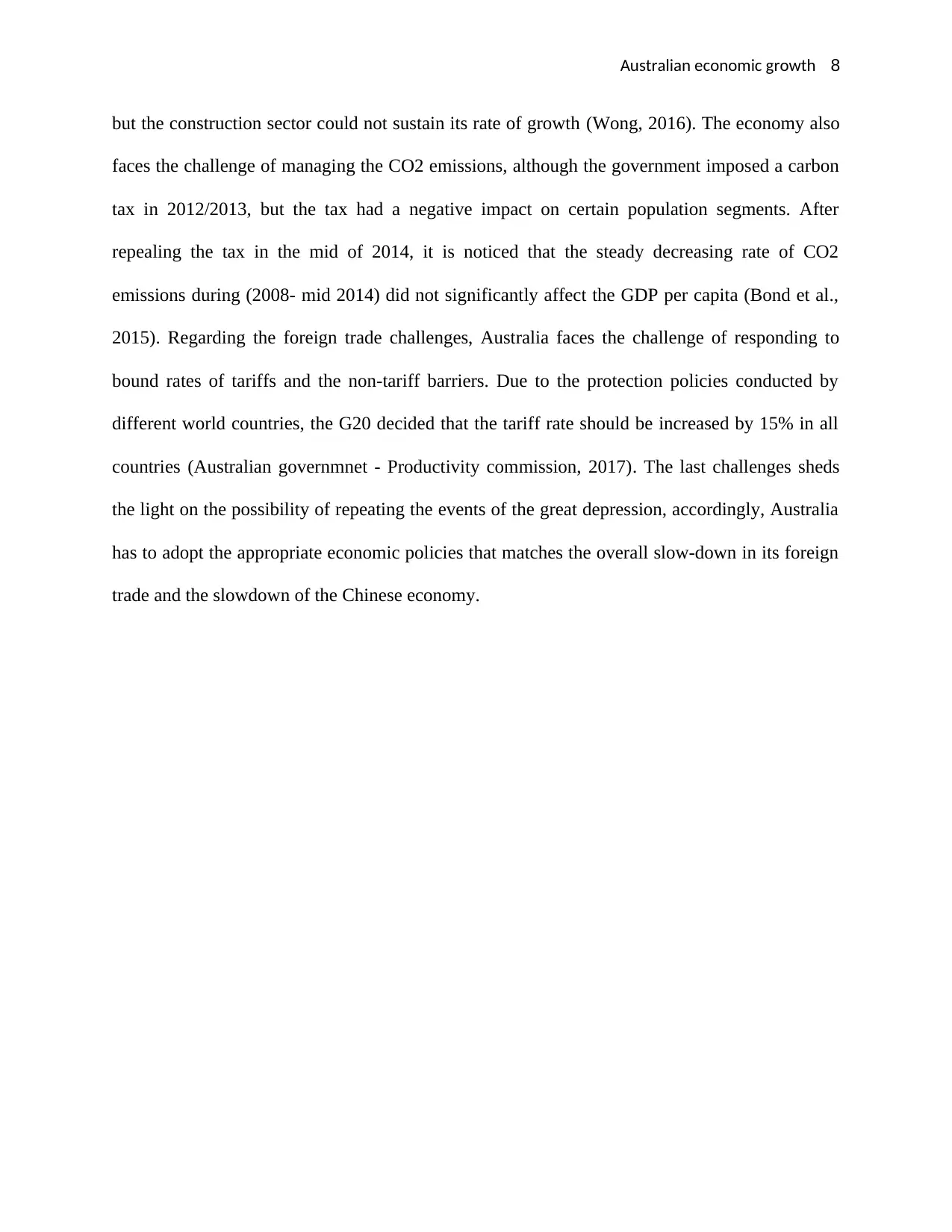
8Australian economic growth
but the construction sector could not sustain its rate of growth (Wong, 2016). The economy also
faces the challenge of managing the CO2 emissions, although the government imposed a carbon
tax in 2012/2013, but the tax had a negative impact on certain population segments. After
repealing the tax in the mid of 2014, it is noticed that the steady decreasing rate of CO2
emissions during (2008- mid 2014) did not significantly affect the GDP per capita (Bond et al.,
2015). Regarding the foreign trade challenges, Australia faces the challenge of responding to
bound rates of tariffs and the non-tariff barriers. Due to the protection policies conducted by
different world countries, the G20 decided that the tariff rate should be increased by 15% in all
countries (Australian governmnet - Productivity commission, 2017). The last challenges sheds
the light on the possibility of repeating the events of the great depression, accordingly, Australia
has to adopt the appropriate economic policies that matches the overall slow-down in its foreign
trade and the slowdown of the Chinese economy.
but the construction sector could not sustain its rate of growth (Wong, 2016). The economy also
faces the challenge of managing the CO2 emissions, although the government imposed a carbon
tax in 2012/2013, but the tax had a negative impact on certain population segments. After
repealing the tax in the mid of 2014, it is noticed that the steady decreasing rate of CO2
emissions during (2008- mid 2014) did not significantly affect the GDP per capita (Bond et al.,
2015). Regarding the foreign trade challenges, Australia faces the challenge of responding to
bound rates of tariffs and the non-tariff barriers. Due to the protection policies conducted by
different world countries, the G20 decided that the tariff rate should be increased by 15% in all
countries (Australian governmnet - Productivity commission, 2017). The last challenges sheds
the light on the possibility of repeating the events of the great depression, accordingly, Australia
has to adopt the appropriate economic policies that matches the overall slow-down in its foreign
trade and the slowdown of the Chinese economy.
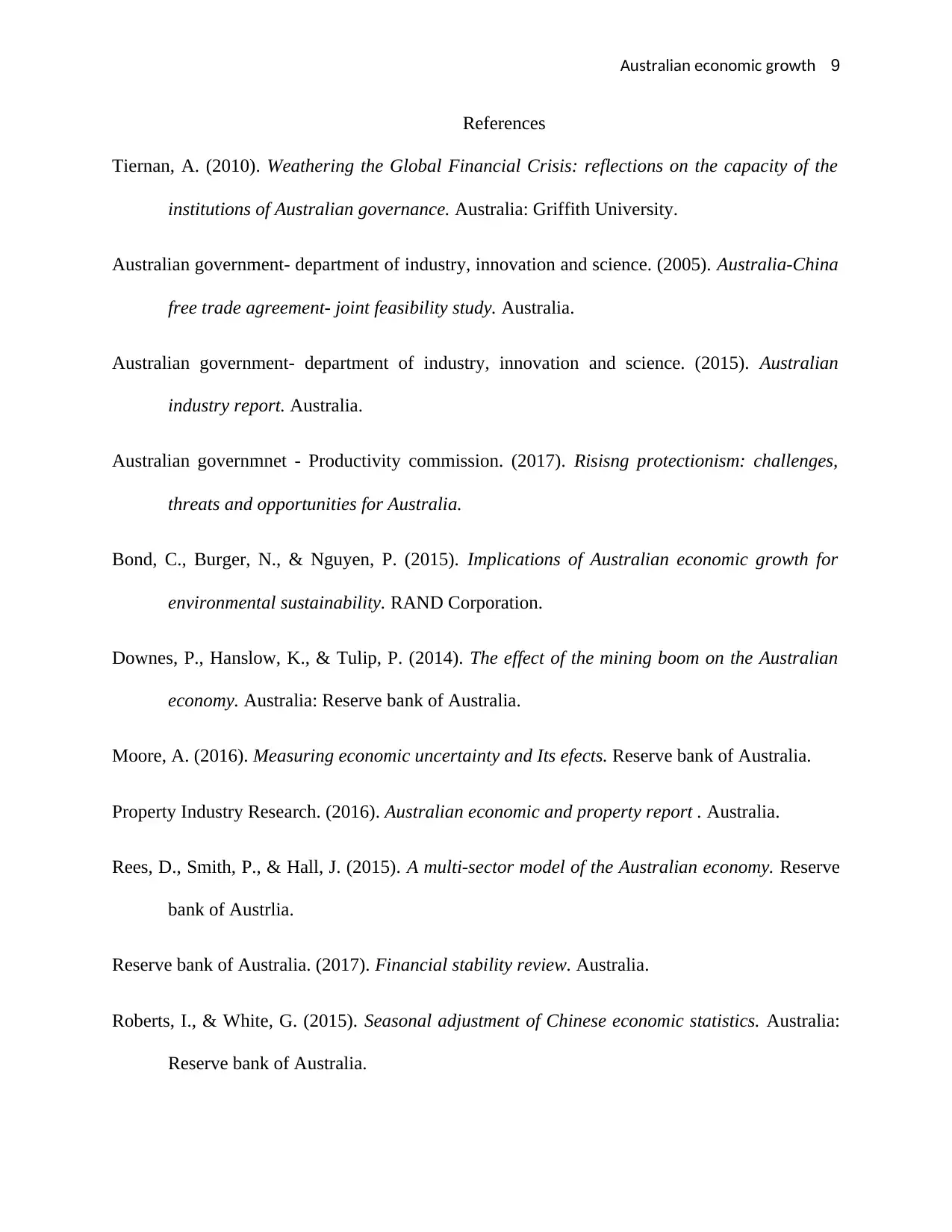
9Australian economic growth
References
Tiernan, A. (2010). Weathering the Global Financial Crisis: reflections on the capacity of the
institutions of Australian governance. Australia: Griffith University.
Australian government- department of industry, innovation and science. (2005). Australia-China
free trade agreement- joint feasibility study. Australia.
Australian government- department of industry, innovation and science. (2015). Australian
industry report. Australia.
Australian governmnet - Productivity commission. (2017). Risisng protectionism: challenges,
threats and opportunities for Australia.
Bond, C., Burger, N., & Nguyen, P. (2015). Implications of Australian economic growth for
environmental sustainability. RAND Corporation.
Downes, P., Hanslow, K., & Tulip, P. (2014). The effect of the mining boom on the Australian
economy. Australia: Reserve bank of Australia.
Moore, A. (2016). Measuring economic uncertainty and Its efects. Reserve bank of Australia.
Property Industry Research. (2016). Australian economic and property report . Australia.
Rees, D., Smith, P., & Hall, J. (2015). A multi-sector model of the Australian economy. Reserve
bank of Austrlia.
Reserve bank of Australia. (2017). Financial stability review. Australia.
Roberts, I., & White, G. (2015). Seasonal adjustment of Chinese economic statistics. Australia:
Reserve bank of Australia.
References
Tiernan, A. (2010). Weathering the Global Financial Crisis: reflections on the capacity of the
institutions of Australian governance. Australia: Griffith University.
Australian government- department of industry, innovation and science. (2005). Australia-China
free trade agreement- joint feasibility study. Australia.
Australian government- department of industry, innovation and science. (2015). Australian
industry report. Australia.
Australian governmnet - Productivity commission. (2017). Risisng protectionism: challenges,
threats and opportunities for Australia.
Bond, C., Burger, N., & Nguyen, P. (2015). Implications of Australian economic growth for
environmental sustainability. RAND Corporation.
Downes, P., Hanslow, K., & Tulip, P. (2014). The effect of the mining boom on the Australian
economy. Australia: Reserve bank of Australia.
Moore, A. (2016). Measuring economic uncertainty and Its efects. Reserve bank of Australia.
Property Industry Research. (2016). Australian economic and property report . Australia.
Rees, D., Smith, P., & Hall, J. (2015). A multi-sector model of the Australian economy. Reserve
bank of Austrlia.
Reserve bank of Australia. (2017). Financial stability review. Australia.
Roberts, I., & White, G. (2015). Seasonal adjustment of Chinese economic statistics. Australia:
Reserve bank of Australia.
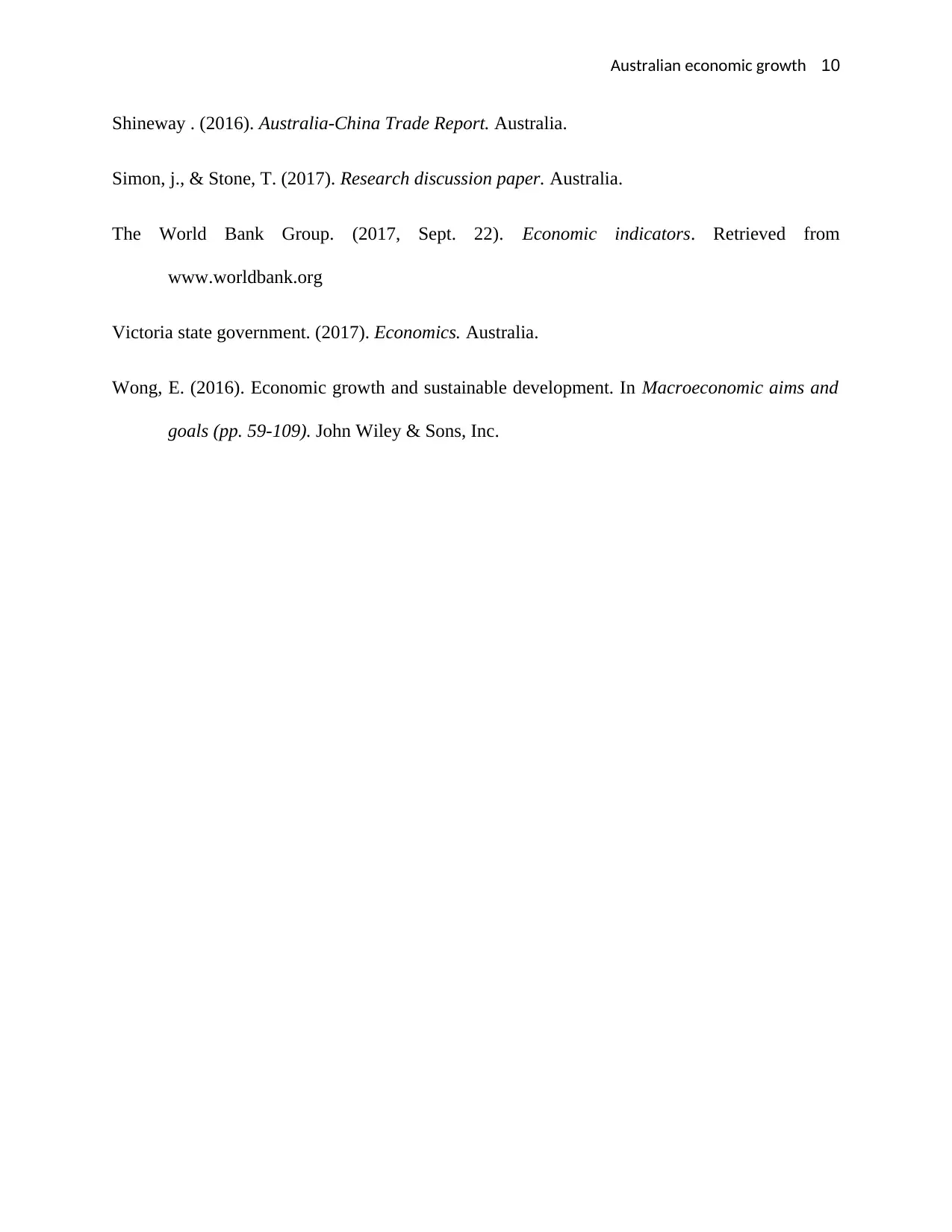
10Australian economic growth
Shineway . (2016). Australia-China Trade Report. Australia.
Simon, j., & Stone, T. (2017). Research discussion paper. Australia.
The World Bank Group. (2017, Sept. 22). Economic indicators. Retrieved from
www.worldbank.org
Victoria state government. (2017). Economics. Australia.
Wong, E. (2016). Economic growth and sustainable development. In Macroeconomic aims and
goals (pp. 59-109). John Wiley & Sons, Inc.
Shineway . (2016). Australia-China Trade Report. Australia.
Simon, j., & Stone, T. (2017). Research discussion paper. Australia.
The World Bank Group. (2017, Sept. 22). Economic indicators. Retrieved from
www.worldbank.org
Victoria state government. (2017). Economics. Australia.
Wong, E. (2016). Economic growth and sustainable development. In Macroeconomic aims and
goals (pp. 59-109). John Wiley & Sons, Inc.
1 out of 10
Related Documents
Your All-in-One AI-Powered Toolkit for Academic Success.
+13062052269
info@desklib.com
Available 24*7 on WhatsApp / Email
![[object Object]](/_next/static/media/star-bottom.7253800d.svg)
Unlock your academic potential
© 2024 | Zucol Services PVT LTD | All rights reserved.





